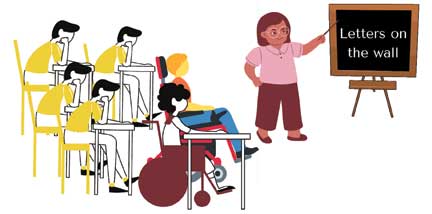Sharoon Sunny
Viraj rushed past the coffee table in the living room, and in that hurry, stubbed his toe. He sat down to soothe the pain, and momentarily forgot the real reason he had rushed back into the house. He wanted to retrieve his paper parachute to deploy from the fourth floor of his apartment complex while at play with his friends. Somehow the pain of stubbing his toe interrupted his gallant efforts to retrieve his giant paper parachute.
While he rubbed his little toe gently, he caught sight of a book turned face down on the coffee table. The title read, I Know Why the Caged Bird Sings. He picked it up because the book had a beautifully illustrated cover page. He looked carefully at the illustrations and almost inadvertently, noticed the name of the author – Maya An-glow, he said to himself.
Interestingly, there were no birds at all on the cover page. The cover had a young girl, about Viraj’s age, walking across a somewhat empty landscape with a book in her hand. Somewhere in the hazy distance was a house, and the young African girl seemed to tower over the house.

He put the book back the way he found it, rushed into his room, retrieved his paper parachute and rushed out of the house. Before he rushed out, he paused for a moment and wondered why there was no bird on the cover page.
That evening, after he returned and he was at the dinner table with the rest of his family, he decided to ask his mother the question that had bothered him all evening.
“Amma, I noticed the title of the book you were reading, I Know Why the Caged Bird Sings, but there are no birds on the cover page. Where are the birds?”
As they ate, he watched his parents, mix the rice and curd with their hands, roll small balls, and coat them with the pickle and vegetables and relish them. He could never understand why they enjoyed a variety of textures and tastes all at once – sour mixed with salty, spicy with a tinge of sweetness. While these thoughts went on in his head, his mother tried to explain how the memoir was a coming-of-age book and that the title was a metaphorical reference to how a young black girl growing up in a whites-dominated country fighting oppression and racism eventually became one of the most celebrated writers in the world.
Dinner was a wholesome meal of rice, curd and kootuporiyal. Although the meal was light, the conversation was somewhat heavy and Viraj continued to have questions about what his mother said. As a brown boy, growing up in Bangalore, his understanding of racism was slightly limited.
He told his parents that words like racism, segregation and oppression were all familiar, but somehow he could not truly understand them. He asked his mom if segregation meant what she did with the vegetable waste in the earthen Kambha: “Amma, so segregation means keeping things separate, right? Like you keep the cooked waste separate from the vegetable waste for composting?”
Ranjini found these moments of conversations a real reprieve for she realized how she could transform them into meaningful and engaging exchanges. Viraj was a gifted child. His abilities were above par, and he always stood out amongst his peers. Unfortunately, his intelligence also made him a sitting duck. Ridiculed and bullied often, he would retreat into his books to keep from talking lest his friends continued poking fun.
She would use these moments to get him to talk about how he felt or what those moments of made him think of. She asked him why they felt particularly hurtful.
“I felt like an outcast in a place where I had every right to be like everyone else. They always called me names like walking encyclopedia or nerd. They saw me only as an information generating machine. They never saw me for me, amma.”
His mother explained to him that oppression and segregation had similar undertones where one set of people, who felt superior to others, set the parameters on how others who did not match their criteria were to be defined. If they did not meet the set criteria, then accordingly, those people were considered inferior or that they did not belong.
Some things became clear in his 11-year-old mind, while others remained hazy. He instantly made a connection to his history lesson on slavery. Promptly making an observation, he asked his mother if Maya An-glow was a slave. He asked his mother why his history teacher could not explain slavery in the same way.
“We are learning about slavery in our history lesson, but my teacher only reads from the textbook. She discusses the points at the back of the lesson and reads out meanings of difficult words as they are given in the textbook. So much is left out when she teaches this way.”
Wanting to homeschool Viraj, but never mustering up the courage, Ranjini used moments like these to allow her son to explore ideas in a deeper manner. What he shared about school would be peppered with how his teachers had a hard time marrying vocabulary into writing or finding ways to keep students interested.
He always had anecdotes to share with her when he returned from school. During his English class one day, his teacher, in the middle of a prose lesson, stopped and asked students if they could give her a synonym for the word snatch. She forbade Viraj from responding since she knew he would have a ready answer. After going through 23 children in the classroom, she eventually relented and asked Viraj for a response. He promptly said, ‘usurped.’ The teacher admonished him, saying, “the English language has no such word, Viraj, and you should learn to carry a dictionary to class to help you understand these matters.”
Viraj promptly fished out his dictionary and offered it to his teacher. After flipping through the pages very confidently, to reach the section for words listed under the alphabet ‘U,’ the teacher realized she had to shed her veneer of confidence, and arrived a new word in her vocabulary.
These anecdotes made them laugh, but Ranjini worried she willingly sent her son into classrooms with grim teachers who oppressed hapless students with dreary rituals of robotic recitation. She recalled her childhood days and felt Viraj’s teachers were simian throwbacks.
Then came the awful pandemic spreading its tentacles in disastrous ways, and not before long, she saw the insidious ways in which teaching began to make monkeys out of students.
 Online became the new buzz word. Apprehensive teachers, anxious parents and unsuspecting students threw themselves into the deep end. Viraj rejoiced at being able to see his friends finally. With no time spent outdoors, summer went by in a whimper, so the thought of meeting other human beings similar in age seemed deliriously inviting.
Online became the new buzz word. Apprehensive teachers, anxious parents and unsuspecting students threw themselves into the deep end. Viraj rejoiced at being able to see his friends finally. With no time spent outdoors, summer went by in a whimper, so the thought of meeting other human beings similar in age seemed deliriously inviting.
The first few days were ‘fun’. Viraj enjoyed sharing his experiences and listening to other children share theirs. What began as locomotion of gastropods soon gained an unprecedented momentum for a medium no one understood. The teacher started by ‘teaching’ a story.
Viraj watched as the teacher spent the first 15 minutes warning all students not to switch off their videos or not to ‘chat’ while class was in session. With a combination of Teams and PowerPoint, the teacher suddenly seemed invincible. The teacher’s voice echoed in his room; filling all the empty corners with words like, “understood children?” “No need to ask such questions.” If a student wanted to clear his doubts, the teacher seemed deaf to it. He wondered how the author of the story would feel if he saw his story being reduced to a few slideshow presentations.
Similarly, his biology teacher broke into a slide after slide explanation about parts of a flower. “Tell me, children, what is an anther?” The answer was evidently on the screen, and the children read that out one after another, creating a raucous. Soon the students were warned not to speak out of turn. “Sejal, tell me, what is an anther?” But Sejal never got an opportunity to respond. Udantika did, and so did Jonathan and Veeresh and the 40 other children who were now waiting for a chance to just have their voice heard. The teacher was unmitigated in her march of knowledge creation.
That afternoon, after sitting through an endless set of slides about prepositions, integers, plants, Mesopotamians, Viraj recreated his class. Combining math, science and English, he set off on creating explanations about the world that made sense to him.
Chemistry and physics were introduced this year and with it began a fascination for chemical reactions and preoccupation with various physics-related concepts.
 Since the city was in lockdown, he knew he could not go out to purchase things that he might need for his experiments. Rummaging through the utility cabinet, he found a bottle called Mr.Muscle. Wanting to create hydrogen gas, he coaxed his mother into helping him fill up a glass bottle with Mr. Muscle and cap it with a balloon atop its open mouth.
Since the city was in lockdown, he knew he could not go out to purchase things that he might need for his experiments. Rummaging through the utility cabinet, he found a bottle called Mr.Muscle. Wanting to create hydrogen gas, he coaxed his mother into helping him fill up a glass bottle with Mr. Muscle and cap it with a balloon atop its open mouth.
Ranjini obliged. With the mixture of water, aluminium and caustic soda, when the bottle was given a shake, the hydrogen gas began to fill the balloon. Mother and son watched in fascination as the balloon got bigger and bigger and eventually a loud pop filled the garden. Stunned at the explosion, Ranjini took a few moments to regain her composure. She quizzed Viraj about why such an experiment was necessary.
“See, soon it will be that several pockets will go into a containment zone. People will be unable to help other people who need assistance for fear of contracting the virus. I thought if we could have a sufficient number of balloons filled with hydrogen gas, then we could tie packages to them and get them delivered to people in need. This will ensure there is minimal human contact.”
Ranjini, of course, was fascinated. She explained to him that the idea was truly novel, but it may need some tweaking for it to be fully effective.
The next day, Viraj went about collecting all the old newspapers around the house. There were broomsticks, tapes, spools of thread strewn all over the living room. Ranjini watched without asking any questions since she knew he was trying to improvise on his previous idea.
In the end, he created a large parachute and asked for her help to carry it out. Mimicking his principal, Selvaraj, Viraj said, “Ranjini, won’t you help the little boy with his experiment?” He climbed as high as he could and dropped the parachute, it gently came down and settled on the floor. Ranjini caught all of this on video.
“It worked out, ma: air resistance and velocity; I think everything came together well. Will you now send this as a suggestion to the municipal people? They can deploy food packets to needy people.”
The next day, he explained his concept to his physics teacher and walked her through the dimensions of the parachute and how he launched it successfully. The teacher, fascinated by his attempt to help people in need, asked that he videotape his efforts and send it to the school email.
Viraj promptly downloaded his video and sent it to his teacher.
Two days after the incident, he received a certificate of appreciation for his proactiveness to help the needy. It was displayed prominently on his class notice board. All students in his class were now able to watch the video, and some even congratulated him on the experiment. Viraj’s video kick-started a new type of learning initiative among students – hands-on projects.
Students began working on projects with materials at home. Some brought homemade table vacuum cleaners, others automatic sanitisers and soap dispensers, and some wrote original stories and poems.
Suddenly it seemed students were morphing into little inventors, writers and artists. They seemed to need very little instruction to carry out complex tasks and the outputs were far more sophisticated than their grade level instructional materials.
Viraj would share these instances with Ranjini, and again, they would discuss at length why creating things out of nothing seemed more exciting than sitting through regular school.
He promptly broke into his favourite Dr.Suess rhyme,
“Look at me! Look at me! Look at me NOW!
It is fun to have fun. But you have to know how.”
The author is a teacher, and currently a Ph.D. student at the English and Foreign Languages University, Hyderabad. She can be reached at sharoon.sunny@gmail.com.
